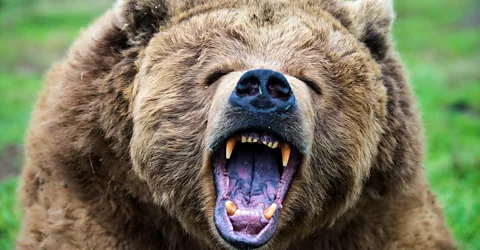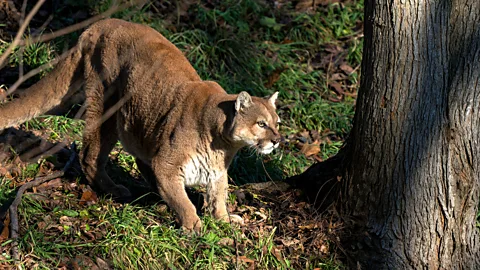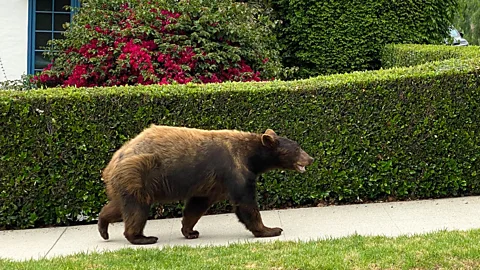
Why do animals attack humans in the wild?
 Getty Images
Getty ImagesFollowing a spate of predator attacks on hikers and park rangers in the US, Ally Hirschlag investigates why animals attack humans in the wild.
Keri Bergere was on a Saturday afternoon bike ride with her friends on the heavily-forested Tokul Creek trail near Fall City, Washington, when two cougars ran out in front of them. One went off into the woods, but the other turned around and, within seconds, had pulled the 60-year-old woman off her bike. “We didn’t have a chance to face off with them to scare them away or anything,” her friend, Annie Bilotta, told the local news station.
The young cougar clamped down on Bergere’s face and would not let go for 15 minutes. Her friends tried everything: they hit it repeatedly with sticks, brought a 25-pound (11.4kg) boulder down on its head and stabbed it with a small knife, all while Bergere kept poking it in the eyes and mouth. When the cougar finally released for a moment and Bergere could get away, her friends pushed a bike on top of it, holding it down until help arrived. Bergere survived but sustained significant, permanent nerve damage to her face.
In Haines Junction, Yukon, Vanessa Chaput was out for a run with her dog when she saw three grizzly bears. As a Kaska woman who grew up encountering apex predators, Chaput knew to give them a wide berth, she told APTN News. But when her dog got off-leash, one of the bears charged her and clamped its jaws onto her head. Luckily, she’d been wearing a claw clip that broke in the bear’s mouth, startling it enough to release her. Her dog’s barking then distracted the bear long enough for her to run to the highway and call for help. She was left with puncture wounds up and down her arm, a broken bone, nerve damage and torn triceps.
Neither Bergere nor Chaput did anything to provoke these altercations; they’re considered unexpected encounters, which occur when carnivores and humans happen upon each other, and the surprise element incites defensive behaviour in the animal. Chris Servheen, a retired grizzly bear recovery coordinator for the US Fish and Wildlife Service, says it’s the most common type of bear attack he’s seen. “Usually, the bear tries to knock the person down or neutralise the person because it’s afraid and then runs away,” he explains.
“There is a lot of attention around these attacks, but in reality the number of attacks is very low,” says Vincenzo Penteriani, a researcher for the Spanish National Research Council (CSIC). According to a 2023 study co-authored by Penteriani, there were 5,089 large carnivore attacks worldwide between 1950 and 2019. Only 32% of those resulted in human fatalities, with two-thirds of these fatalities caused by large cats such as lions and cougars.
 Getty Images
Getty ImagesThere are three other common drivers for carnivore-human attacks, some of which are more preventable than others. Natural aggression-based conflicts – such as those involving females protecting their young or animals protecting a food source – can often be avoided as long as people stay away from those animals and their food.
Carnivores that recognise humans as a means to get food, are a different story. As they become more reliant on human food they might find at campsites or in rubbish bins, they become less avoidant of humans. Losing that instinctive fear response puts them into more situations where they could get into an altercation with a human, which often results in that bear being put down by humans. “A fed bear is a dead bear,” says Servheen, referring to a common saying among biologists and conservationists.
Predatory or predation-related attacks are quite rare, only accounting for 17% of attacks in North America since 1955. They occur when a carnivore views a human as prey and hunts it like it would any other animal it uses for food. A recent example of a predatory encounter is the mountain lion that killed a 21-year-old and severely injured his brother in El Dorado County, California. It was the first predatory attack the state had seen in 20 years.
Then there are animal attacks provoked by people taking pictures with them or feeding them in natural settings such as national parks which often end with animals being euthanised out of precaution. “Eventually, that animal becomes habituated to people, and [then] bad things happen to the animal. And the folks who initially wanted to make that connection don’t necessarily realise that,” says Christine Wilkinson, a postdoctoral researcher at UC Berkeley, California, who’s been studying coyote-human conflicts.
After conducting countless postmortems on all types of carnivore-human attacks spanning 75 years, Penteriani’s team believes 50% could have been avoided if humans reacted differently. A 2017 study co-authored by Penteriani found that engaging in risky behaviour around large carnivores increases the likelihood of an attack.
Two of the most common risky behaviours are parents leaving their children to play outside unattended and walking an unleashed dog, according to the study. Wilkinson says 66% of coyote attacks involve a dog. “[People] end up in a situation where their dog is being chased, or their dog chases a coyote, or maybe they’re walking their dog near a den that’s marked, and the coyote wants to escort them away,” says Wilkinson.
 Getty Images
Getty ImagesPenteriani‘s research indicates large carnivore attacks steadily increased from 1950 to 2019 (although that may be somewhat influenced by a concurrent increase in the reporting of wildlife-human conflicts). There are a few key reasons for this. In recent decades, carnivore conservation and population recovery efforts have proven rather effective. “The population of grizzly bears is five times what it was 40 years ago in the lower 48 states,” says Servheen.
Urban sprawl in high-income countries is the more concerning reason. Servheen says people who move from cities out into the countryside often don’t know or take the time to learn how to respect the wildlife that lives there. This results in careless behaviour, such as having rubbish bins that aren’t animal-proofed, which can ultimately turn carnivores into food-conditioned threats.
Experts believe climate change also plays a part in the escalation of human-carnivore conflicts, but the correlation still needs to be ironed out. “As finite resources become scarcer, carnivores and people are coming into more frequent contact, which means that more conflict could occur,” says Jen Miller, international programme specialist for the US Fish & Wildlife Service. For example, she says, there was an uptick in lion attacks in western India during a drought when lions and people were relying on the same water sources.
Climate change is also shortening winter and lessening snow coverage in the northern hemisphere, which Servheen says may be causing bears to end hibernation before the food they typically rely on – insects and flora – is widely available. “As they go downhill [in search of food], they get into [valleys] where there are lots of people,” he says.
The likelihood of human-carnivore conflicts appears to be higher in areas of low-income countries dominated by vast rural landscapes and farmland, according to Penteriani’s research. “There are a lot of working landscapes in the Global South that are really heterogeneous, that are interspersed with carnivore habitats, forests and savannahs, which creates a lot more opportunity for these encounters, just statistically,” says Wilkinson.
In these areas, carnivore populations are larger and more widespread. Since the people living there rely on agriculture and livestock for their livelihoods, there’s more opportunity for them to come into contact with these carnivores, Wilkinson says. This habitat overlap sets the stage for a vicious loop of human-animal conflict, resulting in many more animal deaths than human ones.
“Violence – both retaliatory and preventative killing of wildlife – can become the only option for [livestock] producers to carve out a living or have enough to feed their families in some places,” says Feldman.
Experts resoundingly say removing the animal is not the answer. When that becomes the go-to reaction, it can lead to a sharp population decline and the threat of extinction, as was the case with gray wolves in the US pre-1960, says Penteriani, adding: “You have to do something to prevent and reduce the possibility of an attack”.
Human-wildlife conflicts might seem unavoidable as populations increase and carnivore habitats, but there are ways to minimise your risk of being involved with one. It starts with getting a better understanding of the carnivores in your area and what might attract them to you, or which situations could leave you vulnerable.
“A lot of the power for these situations is in your hands, whether it’s from knowing the animal behaviour or from having the right tools to use in one of these rare situations,” says Wilkinson. Wilkinson suggests bringing bags to always keep food in while camping, carrying bear spray in bear country in case of an encounter and keeping dogs on a leash so they don’t draw out carnivores.
There are some general guidelines for preventing attacks. Penteriani stresses it’s important to sticking to groups of at least three adults when in carnivore territory; and if you’re walking your dog, always keep it on a leash, even in more urban areas on the fringe of wilderness. Avoid spending time outside during sunrise or sunset; this is when carnivores tend to be most active. If you see a carnivore, the US Fish and Wildlife Service suggests staying at least 100 yards (91m) away or the length of a football field.
 Getty Images
Getty ImagesKeeping these animals from becoming habituated and food-conditioned is one of the biggest challenges, especially as more people move into the backcountry. Servheen helped create the Bear Smart community programme to address this; it’s a template for how to live in bear habitats and has already been implemented in communities across Montana. It includes securing your attractants by using bear-proof rubbish bins, putting electric fences around livestock and gardens, never leaving food outside and carrying protection when camping, such as bear spray.
Penteriani says preventative measures like these should ward off the majority of carnivore attacks. But even if one proves imminent, you can still take steps to avoid injury.
If you encounter a cougar or another large felid, don’t run (Wilkinson stresses they will think you’re prey and can easily outrun you), but rather slowly make yourself as big and menacing as you can. Clapping your hands, kicking the ground and even charging the animal will likely scare them off.
Follow all the same steps with bears. The National Park Service also suggests speaking calmly to show you’re human (and a bigger threat to them). You never want to turn your back or climb a tree, as grizzly and black bears can climb better than you can.
When an attack can’t be prevented, defensive manoeuvres can help you avoid serious or life-threatening injury, but they vary by animal. With a grizzly bear, Wilkinson says you’ll want to play dead, lying on your stomach or covering the most vulnerable parts of your body with a backpack. It’s also a good idea to cover your head with your arms. Black bears, on the other hand, should be fought with all your might as you’re more likely to succeed against the smaller animal.
You also want to fight back against cougars and similar felids, as Bergere and her friends did. Use anything at your disposal to get the animal off you and then threaten or subdue it with whatever you have (rocks, branches, a bike) until it runs away or help arrives.
Ultimately, avoiding conflicts with animals comes down to respecting them by setting boundaries so they can do the same. Peaceful coexistence is possible, but as the dominant species, humans have to take more initiative to make it work, says Miller.
“If the people living with carnivores can be supported and given what they need to coexist, then human-carnivore coexistence is possible,” says Miller. “Coexistence is happening successfully all over the world, even in the face of climate change.”




